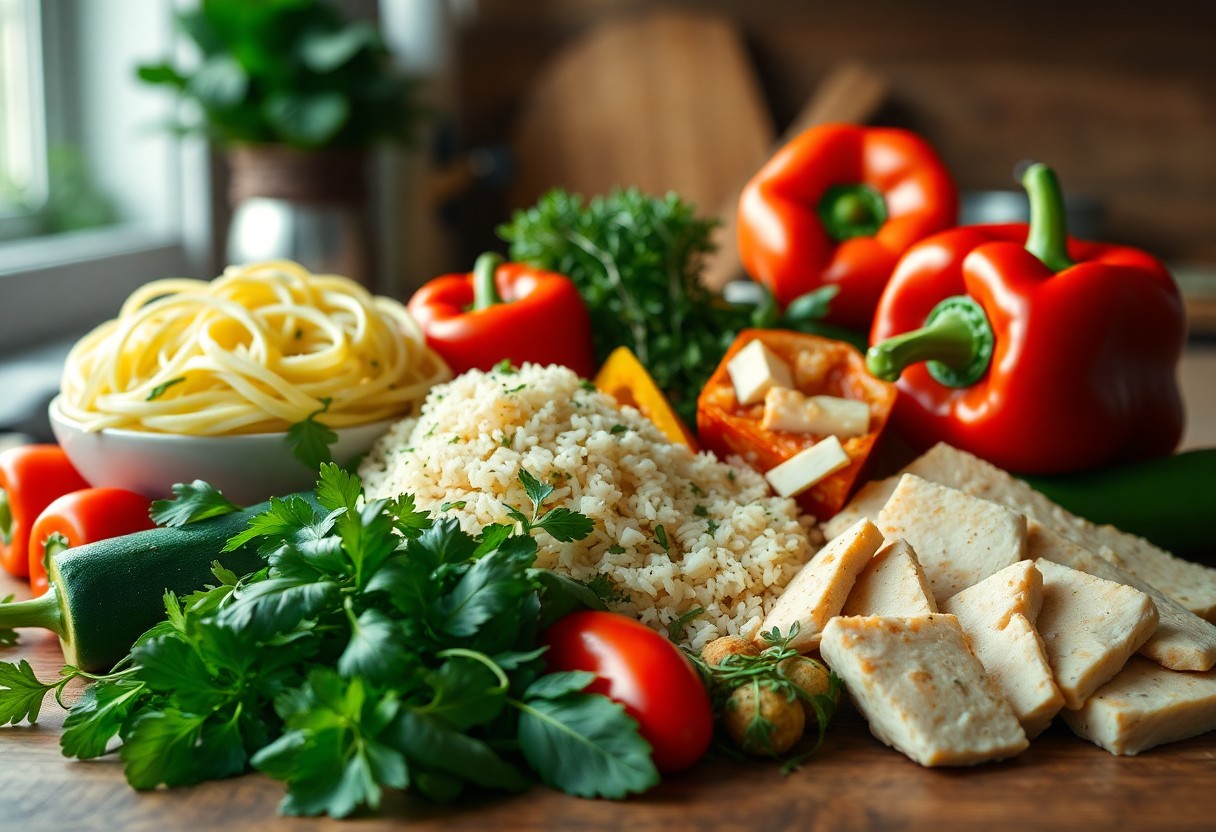The Ultimate Guide To Low-Calorie Ingredients For Cooking
Smart Technology Advancements – Redefining Transportation For Tomorrow
April 1, 2025Understanding Futuristic Technology – Key Innovations To Watch
April 2, 2025Most people struggle to find ways to enjoy delicious meals while keeping their calorie intake in check. In this guide, you will discover low-calorie ingredients that not only enhance the flavor of your dishes but also help you maintain a healthy lifestyle. By incorporating these ingredients into your cooking, you can savor satisfying meals without the guilt, allowing you to feel energized and empowered. Dive into the world of nutrient-rich, low-calorie options that will transform your culinary experience and support your wellness goals!
Key Takeaways:
- Ingredient Substitutions: Discover alternative ingredients that provide the same flavor or texture but with lower calories, helping to maintain your favorite recipes.
- Flavor Enhancement: Learn about low-calorie spices, herbs, and condiments that can enhance the taste of dishes without adding significant calories.
- Cooking Techniques: Understand how using specific cooking techniques, such as grilling or steaming, can minimize calorie content while preserving taste and nutrition.
Types of Low-Calorie Ingredients
A variety of low-calorie ingredients can elevate your cooking while keeping your meals light. These ingredients can be classified into categories for easier reference:
| Vegetables | Fruits |
| Lean Proteins | Dairy Alternatives |
| Whole Grains | Herbs & Spices |
| Healthy Fats | Natural Sweeteners |
| Broths | Condiments |
Recognizing these categories can help you make informed choices when planning your meals.
Vegetables and Fruits
Some vegetables and fruits are inherently low in calories and rich in nutrients. Incorporating options like spinach, zucchini, and berries into your dishes can enhance flavor while minimizing calorie intake. These choices not only add vibrant colors to your plate, but they also provide important vitamins and minerals necessary for good health.
Protein Sources
Ingredients that serve as protein sources are integral to a balanced diet. Sourcing low-calorie proteins such as chicken breast, tofu, and fish can provide the necessary energy while keeping calorie counts low.
This encourages you to select lean proteins like skinless turkey or egg whites which offer the benefits of muscle building without excess calories. It’s ideal to steer clear of high-fat meats, as they can significantly increase your calorie intake. Incorporating these lean options can support your dietary goals, while still providing the important nutrients your body needs.
Tips for Incorporating Low-Calorie Ingredients
If you want to seamlessly incorporate low-calorie ingredients into your meals, consider the following tips:
- Start by substituting high-calorie items with their lower-calorie counterparts.
- Experiment with herbs and spices to enhance flavor without calories.
- Plan your meals using seasonal produce for fresh options.
- Combine colors and textures for visually appealing dishes.
Thou will find that small adjustments can yield satisfying results in your cooking.
Cooking Techniques
There’s an array of techniques you can utilize to preserve flavor while keeping the calorie count low. Grilling, steaming, and baking are excellent methods that enhance the natural taste of ingredients without adding extra fats or sugars. Try sautéing vegetables in broth instead of oil, or opt for poaching proteins to maintain moisture without the additional calories.
Flavor Enhancements
You can elevate your meals using various flavor enhancement techniques while keeping them low in calories.
LowCalorie cooking doesn’t have to sacrifice taste! Incorporate citrus juices, such as lemon or lime, and vinegars to brighten up dishes. Utilize umami-rich ingredients like mushrooms or fermented products for depth. Additionally, experimenting with spices and herbs allows you to create bold flavors without adding extra calories. Your meals can be delicious, satisfying, and still fit within your dietary goals!
Step-by-Step Guide to Meal Preparation
Unlike traditional cooking methods that can be time-consuming, meal preparation helps you stay organized and on track with your dietary goals. Start by gathering your ingredients and tools, then follow a structured plan for cooking and storage. This approach not only saves time but also reduces the temptation to reach for unhealthy snacks.
| Meal Prep Steps | Description |
|---|---|
| Plan Your Meals | Outline weekly meals to ensure variety and balance. |
| Shop Smart | Make a shopping list and stick to it to avoid impulse buys. |
| Cook in Batches | Prepare large quantities to save time during the week. |
| Store Wisely | Use containers that keep your meals fresh and easy to access. |
Planning Your Meals
Any successful meal preparation starts with careful planning. Consider your dietary preferences, nutritional needs, and schedule when designing your meal plan. By planning ahead, you’ll not only save time but also make healthier choices that align with your low-calorie cooking goals.
Portion Control Strategies
One effective way to maintain your calorie goals is through portion control. By being mindful of serving sizes, you can enjoy your favorite meals without exceeding your desired intake. Use measuring cups, a food scale, or simply your hand as a guide to help you understand appropriate portions.
It’s important to be aware that overestimating portion sizes can lead to consuming more calories than intended, potentially hindering your progress. By utilizing portion control strategies, such as visual cues and pre-portioning meals, you’ll find it easier to stick to your dietary goals. Additionally, being consistent with these strategies can positively impact your overall health, helping you to feel satisfied without the extra calories that come from larger portions.
Factors to Consider When Choosing Ingredients
Many individuals overlook important aspects when selecting low-calorie ingredients for their meals. Here are key factors to consider:
- Nutritional content
- Availability
- Cost
- Flavor profile
- Preparation time
The goal is to make healthy choices that suit your lifestyle and culinary preferences.
Nutritional Value
While evaluating low-calorie ingredients, focus on their nutritional value. Opt for items that are rich in vitamins, minerals, and fiber, while still being low in calories. Ingredients like leafy greens, legumes, and whole grains not only help you feel full but also provide vital nutrients that support your overall health.
Availability and Cost
With the right planning, you can choose low-calorie ingredients that are both affordable and accessible. Shopping at local farmers’ markets or supermarkets can help you find fresh, seasonal produce at lower prices.
When you decide on your meals, consider that availability often varies depending on where you live. Seasonal ingredients can benefit your taste and cost-effectiveness, allowing you to access fresher options at lower prices. Additionally, bulk purchasing can reduce expenses, especially for pantry staples like whole grains and beans. Always keep an eye on local sales and promotions, so you can maximize your budget while still enjoying nutrient-rich meals.

Pros and Cons of Low-Calorie Cooking
Not all low-calorie cooking methods yield beneficial results. While they can help with weight management, they also come with potential downsides that you should consider before diving in. Here’s a breakdown of the advantages and challenges:
Pros and Cons
| Pros | Cons |
|---|---|
| Promotes weight loss | May compromise flavor |
| Encourages healthy eating habits | Can require more preparation time |
| Utilizes fresh ingredients | Higher cost for specialty items |
| Supports heart health | Potential lack of vital nutrients |
| Lower risk of chronic diseases | May lead to feelings of deprivation |
To learn tips on how to make healthier dishes, check out Modifying a Recipe to Be Healthier | Ohioline.
Health Benefits
While low-calorie cooking can promote weight loss and better health, it’s important to focus on nutritious, whole ingredients. By opting for lower-calorie options, you’ll likely consume more vitamins, minerals, and antioxidants, which can enhance your overall well-being and energy levels.
Potential Drawbacks
Now, low-calorie cooking isn’t without its challenges. You may find that some recipes lack the richness and satisfaction that traditional dishes offer, leading to a potential decrease in enjoyment during meals.
Cooking with low-calorie ingredients often makes you feel like you’re sacrificing taste and satisfaction. If you cut back too drastically, your meals may result in unappealing flavors or textures that don’t satiate your cravings. Additionally, focusing excessively on calorie counts can distract you from the nutrition your body truly needs, possibly impacting your overall health. Striking a balance between calorie control and enjoying flavorful meals is vital for long-term success.
Frequently Asked Questions
Once again, you might be wondering what low-calorie ingredients truly offer the best nutritional benefits. Low-calorie options like zucchini noodles, cauliflower rice, and Greek yogurt can help you maintain a balanced diet without sacrificing flavor. You should also be aware that some alternatives may contain added sugars or unhealthy fats, so always check nutrition labels. Overall, incorporating these ingredients not only supports your health goals but allows for culinary creativity in your kitchen!
Conclusion
As a reminder, incorporating low-calorie ingredients into your cooking can significantly enhance your meals while supporting your health goals. By knowing how to choose and use these ingredients effectively, you can create delicious dishes that satisfy your taste buds without the extra calories. Experiment with a variety of herbs, spices, vegetables, and alternative cooking methods to develop a diverse and enjoyable culinary experience. Embrace the journey of flavorful, nutritious cooking and watch your well-being flourish.
Q: What are some common low-calorie ingredients that can be used as substitutes in cooking?
A: There are various low-calorie ingredients that can effectively replace higher-calorie options in your cooking. For example, you can use Greek yogurt instead of sour cream, which significantly cuts calories while adding protein. Cauliflower can be mashed as a lower-calorie alternative to mashed potatoes. Additionally, zoodles (zucchini noodles) serve as a great substitute for traditional pasta, allowing you to enjoy your favorite dishes with fewer calories.
Q: How can I incorporate low-calorie ingredients into my everyday meals?
A: Incorporating low-calorie ingredients into your meals can be easy and delicious. Start by adding more vegetables to your dishes; they are generally low in calories and high in nutrients. For breakfast, consider using egg whites or incorporating spinach and peppers into your omelets. For lunch or dinner, you can prepare salads with leafy greens as a base and add lean proteins such as grilled chicken or chickpeas. Don’t hesitate to experiment with herbs and spices to enhance flavors without adding extra calories.
Q: Are low-calorie ingredients still nutritious despite their lower calorie content?
A: Yes, many low-calorie ingredients are not only lower in calories but also packed with necessary nutrients. For instance, foods like vegetables, fruits, and lean proteins provide vitamins, minerals, and fiber while keeping calorie counts low. Ingredients such as quinoa and lentils are also low in calories and rich in protein and fiber, making them nutritious options. It’s necessary to focus on whole, minimally processed foods to ensure you are getting the necessary nutrients alongside reduced calorie intake.
NEWSLETTER






